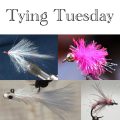How to Tie the Parachute Purple Haze
Producer: tightlinevideo
Andy Carlson—a longtime guide and owner of Bitterroot Anglers in Hamilton, Montana—came up with the Purple Haze way back in 2000, and it has become a fly-box staple as both a searching pattern and as an imitation for several mayfly hatches. In the past, Tim Flagler of Tightline Productions has taught us a few versions of the pattern, including the original and a cripple/emerger Purple Haze .
Here, Tim demonstrates his favorite method for tying the standard parachute version, including ways to make the fly easier to tie and more durable. He admits to a bit of “careless trimming” at the end, which I appreciate his leaving in. It shows the rest of us duffers that A. even the experts make these little mistakes, and B. the fish don’t care.
Parachute Purple Haze
Hook: Dry-fly hook (here, a Fulling Mill 5050), size 12-20.
Thread: White, 8/0 or 70-denier.
Tail: Moose body hair.
Wing post: White polypropylene floating yarn.
Body: Wine rabbit-fur dubbing.
Tail: Moose body hair.
Hackle: Brown and grizzly hackle, mixed.
Adhesive: Head cement (here, Sally Hansen Hard-as-Nails).
Tools: Plunger-style hackle pliers, whip-finish tool.
How to Tie the Orange Shrimp
How to Tie the Pat's Plus











